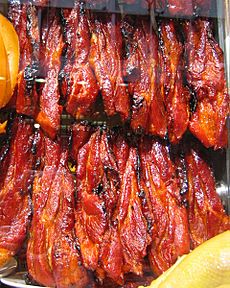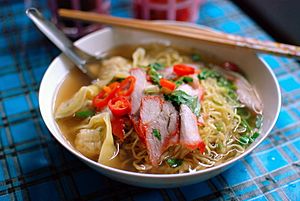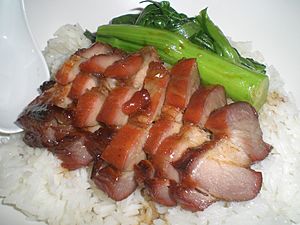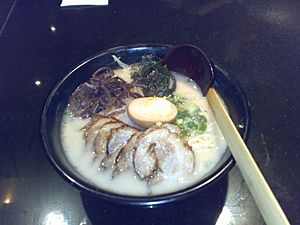Char siu facts for kids

A rack of cha siu pork
|
|
| Alternative names | chasu, char siu, chashao, cha sio, char siew (Cantonese), xá xíu (Vietnamese) |
|---|---|
| Place of origin | Guangdong, China |
| Region or state | Chinese-speaking areas, Japan, Southeast Asia |
| Main ingredients | Pork, mixture of honey, five-spice powder, fermented tofu (red), dark soy sauce, hoisin sauce, and sherry or rice wine |
| Char siu | |||||||||||||||||||||
|---|---|---|---|---|---|---|---|---|---|---|---|---|---|---|---|---|---|---|---|---|---|

"Char siu" in Traditional (top) and Simplified (bottom) Chinese characters
|
|||||||||||||||||||||
| Chinese name | |||||||||||||||||||||
| Traditional Chinese | 叉燒 | ||||||||||||||||||||
| Simplified Chinese | 叉烧 | ||||||||||||||||||||
| Hanyu Pinyin | chāshāo | ||||||||||||||||||||
| Cantonese Yale | chāsīu | ||||||||||||||||||||
| Literal meaning | "fork roasting" | ||||||||||||||||||||
|
|||||||||||||||||||||
| Vietnamese name | |||||||||||||||||||||
| Vietnamese | xá xíu | ||||||||||||||||||||
| Thai name | |||||||||||||||||||||
| Thai | หมูแดง | ||||||||||||||||||||
| RTGS | mu daeng | ||||||||||||||||||||
| Japanese name | |||||||||||||||||||||
| Kanji | 叉焼 | ||||||||||||||||||||
| Kana | チャーシュー | ||||||||||||||||||||
|
|||||||||||||||||||||
| Indonesian name | |||||||||||||||||||||
| Indonesian | babi panggang merah | ||||||||||||||||||||
Char siu is a super popular way to make yummy barbecued pork! It comes from Cantonese cuisine, which is a type of Chinese cooking. Think of it as a special kind of roasted meat called siu mei.
Contents
What is Char Siu?
The name Char siu literally means "fork roasted." This is because of how it's traditionally cooked. Long strips of pork are put onto special long forks. Then, they are roasted in a covered oven or over a fire.
In the past, people used wild boar or other meats to make char siu. Today, it's usually made from a shoulder cut of pork. The pork is seasoned with a special mix of ingredients. This mix often includes honey, five-spice powder, red fermented tofu, dark soy sauce, hoisin sauce, and sometimes sherry or rice wine.
These seasonings give the outside of the meat a dark red color. It looks a bit like the "smoke ring" you see in American barbecue. Sometimes, a sweet syrup called Maltose is used. This gives char siu its famous shiny, glazed look.
Different Pork Cuts for Char Siu
Chefs use different parts of the pig to make char siu. Some common cuts are:
- Pork loin
- Pork belly – This cut makes the char siu extra juicy and a bit fattier.
- Pork butt (shoulder) – This cut makes a leaner char siu.
- Pork fat
- Pork neck end – This part is very marbled, meaning it has nice streaks of fat.
How People Eat Char Siu
Char siu is often eaten with a starchy food. You might find it:
- Inside a soft bun, called chasiu baau (叉燒包).
- With noodles, called chasiu min (叉燒麵).
- With rice, called chasiu faan (叉燒飯).
You can find char siu in fast-food places or as a main dish in traditional family restaurants. If you buy it from a shop, you can take it home. Many families use it as an ingredient in other dishes they cook.
Char Siu in Hong Kong
In Hong Kong, people usually buy char siu from special shops called siu mei establishments. These shops are experts in roasted meats. They sell char siu, soy sauce chicken, white cut chicken, roasted goose, and roasted pork.
These shops often hang the meats in their windows so you can see them. People in Hong Kong often eat char siu with other roasted meats. It's a popular lunch item, often served in a "rice box" meal. You can also buy a whole piece of char siu to take home. Families use it by itself or cook it into other vegetable or meat dishes.
Char Siu Around Southeast Asia

Char siu is also very popular in countries like Malaysia, Singapore, Indonesia, Cambodia, Thailand, and Vietnam. You can find char siew rice at many Chinese shāolà (烧腊) stalls. These stalls also sell roast duck and roast pork.
A typical char siu rice dish has slices of char siu, cucumbers, and white rice. It's usually covered in a sweet sauce or drizzled with dark soy sauce. In Medan, Indonesia, it's called char sio.
You can even find char siew rice at Hainanese chicken rice stalls. There, you can choose to have your char siu with plain white rice or chicken-flavored rice. You can also pick from different sauces like garlic, chili, and soy sauce.
In Thailand, char siu is called mu daeng (หมูแดง), which means "red pork." In Cambodia, it's known as sach chrouk sa seev (សាច់ជ្រូកសាសីុវ).
In the Philippines, it's called Chinese asado. People often eat it with cold cuts or stuffed inside a bun called siopao.
There's even a vegetarian version of char siu! It's usually made from wheat gluten. You can find it in vegetarian restaurants and stalls in Chinese communities in Southeast Asia.
Char Siu in Japan
Japanese culture has its own version of char siu, called chāshū (チャーシュー). It's made a bit differently from the Chinese style. The meat is rolled into a log and then cooked slowly at a low temperature.
Japanese chāshū is usually seasoned with soy sauce, sake, mirin, and sugar. It doesn't typically use red food coloring or five-spice powder. Chāshū is a very common topping for ramen noodles.
Char Siu in the Pacific Islands
Char siu flavors and cooking styles are also used for other meats, especially in Hawaii. The term char siu in Hawaii refers to meats that have been marinated in char siu seasoning. This seasoning can be made from scratch or bought in a package. The marinated meat is then roasted in an oven or over a fire.
The ingredients for char siu marinades in Hawaii are similar to those in China. They include honey, five-spice, wine, soy sauce, and hoisin sauce. However, red food coloring is often used instead of red bean curd because it's easier to find.
In Hawaii, char siu chicken is just as common as char siu pork. People also cook wild birds, mountain goat, and wild boar in the char siu style. Many sausages and skewers are also prepared this way.
Images for kids
See also
 In Spanish: Char siu para niños
In Spanish: Char siu para niños




